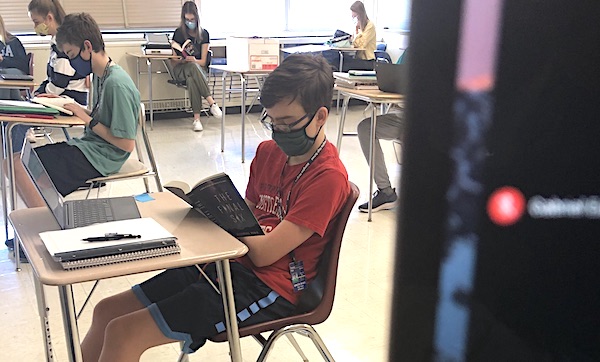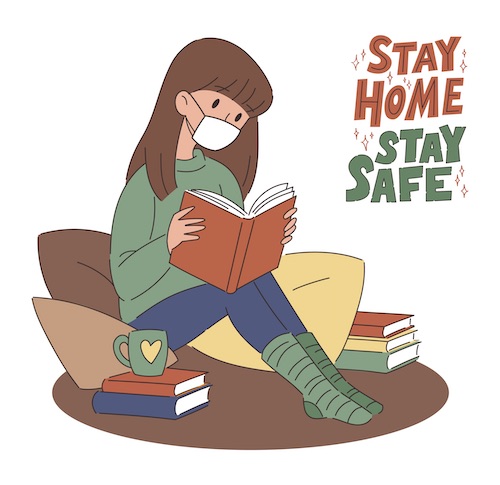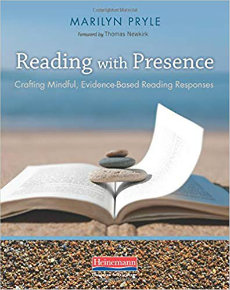Daily Silent Reading in Hybrid Classrooms
My district started the school year virtually, switched to hybrid in October, and we’ve remained hybrid ever since.
At the beginning of the year, I wondered if I would be able to maintain an essential part of my classroom routine: reading silently for the first ten minutes of each class. In my model, students self-select their books and take part in a larger ongoing Book Club activity.
Happily I can report that silent reading is not only possible when remote students are involved, but perhaps more important now than ever.
Running Book Clubs
For several years now, I have run Book Clubs alongside my regular curriculum. With Book Clubs, my 9th and 10th graders can choose their own groups (across any of my classes) and choose their own club books (from the entire universe). I’ve also taught middle school, and I think what I’m about to share is easily adaptable.
There are guidelines.
The books must be a minimum of 150 pages, and each book chosen must be one that’s new to everyone in the group. And of course, the book choices must be ones their parents would approve of.

If a student does not have a group to join, I usually talk to the student about any friends or acquaintances they have in my classes. Then I delicately talk to someone in that group, usually seeking out the person who seems the most mature and kind. So far, it has worked out.
In some cases, I have let students read with a family member for a round or two, but the goal is always to ultimately find a peer group for them.
How to choose books?
Figuring out what to read is an essential skill in Book Clubs. It’s also a skill of lifelong readers. Unfortunately, it is not otherwise cultivated in most children’s school careers. I tell students to ask their friends, parents, and teachers; I tell them to go to Goodreads or Amazon, look up a book they’ve liked in the past, and scroll though the list of “Similar Suggestions” on the page. I also encourage them to browse my classroom library while I offer gentle suggestions.
I knew the physical classroom library would be lost to many students during this virtual/hybrid year and would leave a huge void in the process. But we worked around it. I talked to students individually and made recommendations on Google Classroom. I recorded videos about books and posted them. In the end, the students had no problem choosing books. A few clubs took my recommendations, but the majority of them used Amazon, Google, and Instagram on their own.
They chose fiction, non-fiction, how-to books, and graphic novels. This month’s selections in my class include popular YA titles (like Turtles All the Way Down), some classics (1984), science fiction (The Life Below), manga (Gyo), and non-fiction (Tuesdays with Morrie).
If letting students read any book they want is not possible in your class, consider giving them a list of books to choose from with plenty of selections. This will preserve the element of choice, which is essential in this process.
One group is reading a book about financial principles. Another is reading an electrician’s how-to manual. I used to keep a physical sign-up for the groups on a clipboard on a chalk ledge; this year, I simply made it a Google doc.
How to get the books?
This is another important life skill. This year, I told students that if I had the book, I would arrange to leave a copy in the school office for pick up. Our local library also allows limited numbers inside and as well has curbside pick up.
If you still have a school-wide library, that’s a great resource. I took class time to help students sign up on Libby. Many books are available online for free as PDFs. Several students wanted to buy or download their own copies of the books, since the books were ones they really wanted to read.
It took a bit longer this year, but once students had their groups and books in place, they were ready to read.

Marilyn’s in-class students enjoy silent reading while she is present with her remote silent readers onscreen.
10 Minutes of Silent Reading Every Day
This practice of reading in-class every day is one of the most profound and rewarding shifts in classroom teaching I have made in my career.
I started about five years ago, when I realized that even though students had selected and obtained Book Club books, they were not reading them until the last minute of the cycle (Book Club cycles usually last about five weeks in my class). They were simply cramming whole books into a three- or four-day period, reading as much as they could but not fully enjoying (or even finishing?) them.
When I switched to having students start each class by reading for ten minutes, everything changed. Now, students read, and can’t STOP reading—they often finish their Book Club book in two weeks, or less. They want to know what will happen, so they read during study hall, at home, and during other classes (as much as I love that, I tell them to pay attention instead!).
They beg for extra reading time during class. Once, when I was using an Alexa as a timer, students changed the time limit to 15 minutes when I stepped in the hall to address a visitor. How could I chide them? We read a bit extra that day.
When students finish their books early in the cycle, I tell them to simply read another. For these “surplus” books, they can read whatever they’d like. It doesn’t have to be with their group.
Building in accountability.
I track accountability for this process with a Daily Reading Sheet. It’s not only a log but a way to process what is read. I found that students need a couple minutes to switch gears between reading and diving in to the day’s curricular work, and adding to this chart provides that. I assure them that there are no wrong answers, just thoughts, and that through the chart I can give them “easy points” for doing so much beautiful reading.
The chart asks them to record pages, one or two events, and an idea for a Reading Response, with a category and page number (learn what a Reading Response is here).
Adapting for virtual students.
The ten minutes of reading was the part I was most unsure about in a virtual setting. Would students read on their own, in their rooms, kitchens, or wherever virtual school is for them? There was only one way to find out.
And the answer? Yes! As in a physical setting, students learning virtually love starting the class this way. They love knowing that ten minutes of their stressful day will be put towards reading what they want. They love reading together, in community – even on Google Meet.

This year has proven the truth of that statement more than past years, when I could sit in the back of the room (with my own book, of course) and let my presence be a reminder that I was watching them. This year’s Daily Reading Sheets have shown not only that students are reading, but that they are deeply engrossed in their books, maybe even more than in the past.
What students are saying.
As in past years, this year’s students have reported reduced stress from the ten-minute ritual. Others expressed how much they enjoy knowing some pressure-free time is guaranteed each day, and others have told me how they enjoy connecting with their peers about the books.
Many say that they never liked reading and don’t consider themselves readers, but they loved reading their group’s book. “I hate to tell you this,” I say, “but that makes you a reader who likes to read.”
One student even wrote about Book Clubs for his weekly Edmodo post (read about how I use Edmodo here). He found an article explaining the special benefits of Book Clubs in our virtual lives, which include taking a break from a screen, engaging in authentic discussions, and exploring new books while at home.
Other students on the Edmodo discussion agreed. One said that Book Clubs “help us take our minds off of things for a while and interact with people which is very important today even if it is virtually.” Another said that Book Clubs have “definitely improved my quarantine,” and that having Book Clubs “has allowed me to stay in touch with my friends. Human interaction throughout these past nine months has become much more limited, so it is extremely important to still talk to others, through means such as a book club.”
I won’t pretend that I didn’t tear up when I read these. Whatever extra sense of connection, control, space, growth, or normalcy we can offer students during this difficult time will help them.
Book Club Assessments
In addition to the Daily Reading Sheets, the students have two larger assessments due at the end of each Book Club cycle. First, each student must write a one-page (minimum) review of the book, which will be posted on Goodreads. Second, each group must have a 60-minute discussion about the book. They can break this discussion into two 30-minute sessions if they prefer. I don’t tell students what to talk about; they can discuss whatever aspects of the book that they’d like.
If 60 minutes sounds too long, break down the discussion requirement into two or three 15-minute sessions. These can even be due at short intervals during the cycle, instead of all together at the end.
As proof of this discussion, students must submit either a set of typed minutes or a video. I explain to students the purpose of “minutes” as a genre, and that the minutes should show 1) that 60 minutes was accounted for, and 2) that each person contributed. The easiest way to do this is on a shared Google doc.
Students can call each other or use Facetime and add to the doc with main ideas as they talk. I tell them to use their names or initials with each idea, and color-code each person’s comments, so I can easily see who was talking. If students don’t want to take minutes, they can record the entire session on Zoom and submit it as a video file.
Again, I was surprised at how well this worked in a virtual setting. About three quarters of my groups turned in minutes. As with past years, these ranged from near transcripts (too much!) to basic summaries (too little!). In both cases, I left comments for improvements. But the majority of the minutes landed in the sweet spot – providing convincing evidence of a thoughtful, natural, 60-minute conversation.
The other quarter of my groups turned in video recordings, and the videos were delightful. Students enjoyed “seeing” each other while not on an official class Meet.
My Own Reflection
My experiences with Book Clubs this year reinforce the truths I already know. Students want to read. They want to learn. Giving them control over their choice of books and groups makes them feel invested and engaged. Escaping into a story feels good, especially in these stressful times.
Talking to friends about a book creates genuine connection. And all the things we are trying to teach in English class – comprehension, vocabulary, making inferences, predicting, finding and connecting with themes? Those are still happening too.

Marilyn’s most recent book is Reading with Presence: Crafting Meaningful, Evidenced-Based Reading Responses (Heinemann, 2018). Learn more about her at marilynpryle.com and read other articles she’s written for MiddleWeb.
Edutopia has republished portions of this article.


































